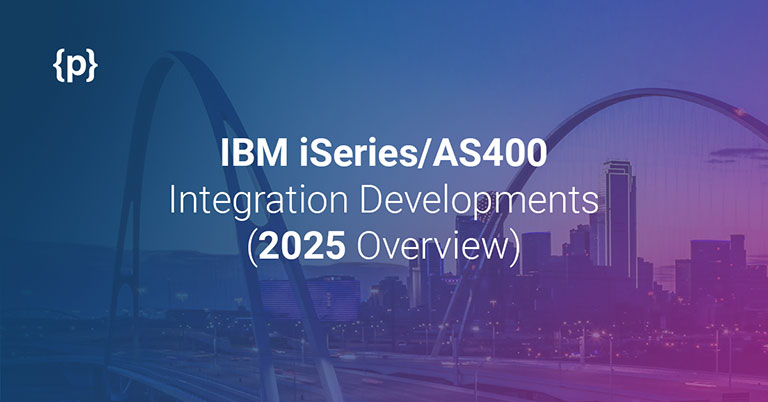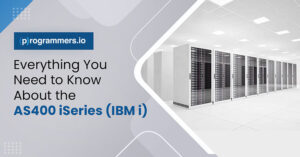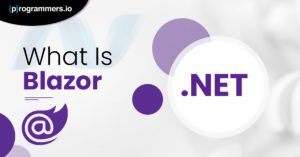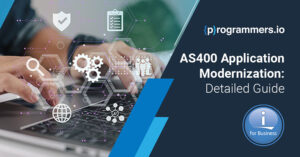Introduction
The idea of enterprise integration for IBM i has undergone a paradigm shift in 2025, and IBM i organizations find themselves at a crucial inflection point. The modern business needs a seamless connectivity between IBM i applications and the broader technology ecosystem.
For decades, IBM i‘s strength lay in its self-contained reliability. Today, that same strength becomes exponentially more powerful when combined with cloud, modern APIs, and modern development practices. This article examines how IBM i organizations can make use of new integration capabilities by keeping their technical investment on IBM i.
Integration with Modern Cloud Platforms
IBM Cloud (Power Virtual Server)
IBM now offers IBM Power Virtual Server on IBM Cloud, enabling IBM i (AS/400) workloads to run on cloud-based Power Systems. This allows seamless hybrid cloud deployments – customers can move IBM i workloads into IBM Cloud data centers while maintaining the security and high performance of on-premises Power hardware.
The Power Virtual Server environment provides direct connectivity to IBM Cloud services and a consistent experience across on-prem and cloud, with support for pay-as-you-go scaling and integrated backup/DR solutions.
For example, an insurance company migrated their IBM i applications from on-premises Power servers to IBM Power Virtual Servers on IBM Cloud, shutting down their private data centers and saving significant costs. This reflects a broader trend of IBM i customers leveraging cloud platforms for agility and hybrid IT integration.
Microsoft Azure (Skytap on Azure)
A popular option for IBM i in the cloud is Skytap on Azure, a service that runs IBM Power infrastructure (IBM i, AIX, Linux) natively within Azure data centers. This offering, developed in partnership with Microsoft, lets organizations lift-and-shift IBM i environments to Azure with minimal changes.
IBM i LPARs can be provisioned on demand in Azure, enabling flexible scaling and low-latency integration with Azure services (for example, using Azure Blob Storage for IBM i backups, and Azure networking for connectivity). Skytap on Azure essentially extends IBM i into the Azure cloud, which is useful for disaster recovery, dev/test environments, or full production migrations.
The migration process typically uses IBM i’s native backup and restore tools (e.g. BRMS) to transfer data into Azure, after which IBM i workloads run on Azure’s Power hardware with the reliability of the Azure cloud platform. This approach is used in industries like manufacturing and retail to modernize legacy IBM i systems by pairing them with Azure’s ecosystem.
Amazon Web Services (AWS)
AWS does not natively host IBM i (since IBM i requires Power Systems), but integration has advanced over the years.
Connectors like InfoConnect Hub enable IBM i systems to integrate with AWS services without extensive manual development. They expose IBM i business logic as RESTful APIs and support real-time event streaming from data queues to services like SNS, SQS, and Kinesis. Deployable on Amazon EC2 or EKS and compatible with API Gateway and CloudWatch, they help modernize IBM i environments using standard AWS practices while preserving core system logic.
In the long term, AWS’s strategy is to offer pathways for IBM i application modernization on AWS. In practice, some organizations use hybrid architectures – keeping IBM i on premises or in IBM Cloud but integrating with AWS services via APIs and SDKs.
With IBM i’s support for modern languages (Java, Node.js, Python), developers can call AWS APIs (for storage, machine learning, etc.) directly from IBM i environments, bridging the AS/400 with AWS’s cloud capabilities.
API Modernization and Web Services Capabilities
Modern IBM i installations are exposing core business logic and data through web services and APIs, allowing AS/400 applications to participate in today’s API-driven economy.
IBM i has a built-in feature called Integrated Web Services (IWS), which makes it straightforward to turn RPG or COBOL programs and SQL queries into SOAP or RESTful web services.
In recent releases, IWS has been enhanced for REST APIs, providing a lightweight REST engine within the IBM i OS for serving JSON/HTTP requests. This means you can quickly create REST endpoints to retrieve or update IBM i data (for example, exposing a Db2 query as a REST GET service) without needing external servers.
IWS handles details like JSON parsing and offers wizards to wrap existing business logic as services, greatly simplifying modernization.
Some benefits of using IWS for API enablement on IBM i include:
- Data Abstraction: You can decouple backend data and programs from front-end applications. By exposing only specific fields or calling specific programs via APIs, IBM i assets can be safely reused without revealing internal complexities.
- Enhanced Security: Rather than opening direct database access, you control exposure by publishing secured APIs. For example, a web service can be limited to returning only certain customer info, enforcing security and compliance at the API level.
- Interoperability: Standard REST/JSON and SOAP services allow IBM i to easily integrate with web and mobile applications, cloud services, and integration platforms. IBM i can both serve APIs (acting as a provider to external apps) and consume APIs (acting as a client calling external web services). In fact, IBM i also includes IWS client support – ILE libraries (like HTTP_FUNCTIONS) let RPG code call out to REST/SOAP APIs on other systems directly from the green screen.
- Modernization & Flexibility: APIs enable a microservices approach. Developers can build new user interfaces (web, mobile) or workflows on top of stable IBM i business logic by calling these services. This preserves proven code while enabling new functionality. It also facilitates cloud adoption – e.g., an e-commerce web app on the cloud can invoke IBM i APIs for inventory or orders.
IBM continues to improve the web service capabilities of IBM i. For instance, IBM i 7.5 added support for HTTP PATCH requests in the IWS server (to better conform to REST standards for partial updates).
On the client side, IBM i’s HTTP APIs now support handling binary data in responses, which is important for calling modern web APIs that might return images or files. In practice, many IBM i shops are using these built-in tools to API-enable their systems.
A 2024 IBM i developer conference showcased how easily one can create a REST API on IBM i using SQL and the IWS wizard – within minutes an RPG developer can expose a database query as a JSON service. All of these advancements mean that IBM i applications no longer have to be monolithic or siloed – they can participate in service-oriented architectures and hybrid cloud workflows.
Additionally, IBM i shops often employ API management solutions (like IBM API Connect or MuleSoft API manager) to govern these services, adding rate limiting, security policies, and developer portals for IBM i APIs just as they would for any modern web service.
Data Integration Tools and Middleware Options
Integration of IBM i data with other platforms is crucial for organizations operating in mixed IT environments. Fortunately, a variety of data integration and middleware tools now support IBM i:
Relational Data Access (ODBC/JDBC)
IBM i’s Db2 for i database can be accessed through standard ODBC and JDBC drivers. IBM provides an IBM i Access ODBC driver that allows any data integration or BI tool (on Windows, Linux, etc.) to query IBM i data using SQL. This makes IBM i data available to modern analytics platforms, ETL pipelines, and even cloud data warehouses. Likewise, IBM i can act as a client to other databases – it supports DRDA and has services to connect to external SQL data sources if needed.
Enterprise Messaging (IBM MQ)
IBM MQ (formerly WebSphere MQ) has a native implementation on IBM i, enabling robust message queue integration between IBM i applications and other systems. Many IBM i shops use MQ to send data or transaction messages to enterprise application buses. The latest IBM MQ on IBM i supports MQ version 9.x features, letting IBM i participate in event-driven architectures and guaranteed-delivery messaging across cloud or on-prem systems.
Change Data Capture and Replication
A major development is the ability to replicate IBM i data in real-time to cloud platforms. For example, InfoCDC captures and streams Db2 for i modern platforms, including AWS SQS, Azure Event Hubs, GCP Pub Sub, JMS, and Kafka, in real-time.
IBM’s own data replication tool (IBM Db2 Mirror and IIDR) also supports IBM i to heterogeneous targets, but many customers use third-party tools for cloud integration.
Integration Platforms and Connectors
Modern integration middleware often includes adapters for IBM i. For instance, InfoviewSystems provides a certified AS/400 connector that can directly call IBM i programs and transactions from a MuleSoft flow. This simplifies exposing an RPG program as a REST API or integrating IBM i with SaaS applications (e.g. sending orders from IBM i to Salesforce) through low-code workflows.
Microsoft’s Azure Logic Apps similarly offers an IBM i connector, allowing Azure cloud workflows to invoke IBM i programs or queries. Other iPaaS and ESB tools (Zapier, Workato, Boomi, etc.) often connect to IBM i via ODBC/JDBC or APIs, demonstrating that IBM i is no longer an island in terms of data integration.
Open Source Integration Tools
IBM i’s support for open source has unlocked a range of integration technologies on the platform. Apache Camel, an integration framework, is supported on IBM i and can be used to route and transform data between IBM i and other systems.
Similarly, Apache Kafka (distributed event streaming) can be deployed or at least interacted with from IBM i, allowing IBM i apps to produce or consume event streams for real-time data sharing. IBM i can run web servers (Apache, Nginx) and web services frameworks that enable it to send/receive data in modern formats (JSON, XML, etc.).
Many organizations use these capabilities to build microservices on IBM i or to push data updates to cloud services in real-time.
Traditional Middleware
Established middleware like IBM WebSphere Application Server and Java EE also continue to support IBM i. IBM i can host Java applications that use JMS, JDBC, and web services to intermediate between legacy code and new systems.
Similarly, IBM Cognos and other IBM analytics tools can directly query IBM i data. Additionally, organizations like Infoview Systems also offer specialized connectors to bridge IBM i with modern UIs, mobile apps, and other databases.
In summary, IBM i shops have an abundance of integration options: whether through real-time data replication to cloud analytics, message queues for asynchronous integration, or direct API and database access for on-demand queries. This ensures that valuable data and transactions on IBM i can feed into broader enterprise data strategies and digital transformation initiatives.
Programming Language Support and Enhancements
One of the most significant developments for IBM i (AS/400) in recent years is its embrace of modern programming languages and open-source tooling. In addition to RPG and COBOL, IBM i now supports a spectrum of languages and runtime environments:
- js: IBM i fully supports Node.js, enabling JavaScript on the server. This opens the door for IBM i shops to build web services, APIs, and even front-end (server-side) applications using a language familiar to most modern developers. Node.js on IBM i can directly call legacy RPG programs or Db2 data through APIs – for example, IBM provides an idb-connector Node package for fast Db2 access on IBM i. Many companies have utilized Node.js to create new web interfaces on top of IBM i or to develop microservices that extend IBM i functionality (such as processing orders and sending data to a web portal in real time). Node.js support also means access to NPM’s huge ecosystem, bringing in packages for everything from web frameworks (Express.js) to AWS SDKs, all running natively on the iSeries.
- Python: Python has become available on IBM i through the PASE environment, with installers via Yum for Python 3.x. Python is used for scripting, automation, and even data science workloads on IBM i. IBM supports an ibm_db Python driver (for Db2 access) and other packages to integrate Python with IBM i databases and programs. This allows uses like data extraction scripts, generating Excel reports directly from IBM i, or even leveraging Python’s machine learning libraries on data pulled from Db2 for i. Python’s readability and large community make it attractive for modernizing utility programs or writing integration code on IBM i.
- PHP: PHP has long been a popular web language on IBM i (thanks to solutions like Zend Server). IBM i continues to support PHP for building web applications that interact with IBM i data. Many IBM i-driven websites and intranets run on PHP, and tools like RPG-XML Suite or Db2 stored procedures can serve data to PHP apps. As of 2025, PHP remains important for IBM i shops built out of LAMP-style stacks.
- Java and JVM Languages: IBM i has a robust Java Virtual Machine and supports Java EE applications. This means languages like Java, Scala, or Kotlin can run on IBM i, and frameworks such as Spring or Hibernate can be used directly against Db2 for i. Java remains crucial for enterprise integration (e.g., running Kafka clients or IBM MQ clients on IBM i). IBM’s open-source support list even includes big Java frameworks (Tomcat, Spring, etc.) for IBM i. Thus, IBM i can participate in enterprise Java development and leverage millions of Java developers’ skills.
- Other Open Source Tools: In addition to languages, IBM i supports a suite of open source tools: Git for version control, cURL and Wget for web calls, GCC for compiling open C/C++ code, and automation tools like Ansible modules for IBM i. Package managers (yum and rpm) are available on IBM i to easily install and update open-source software. IBM has even partnered with Perforce OpenLogic to provide commercial support for open source packages on IBM i, covering dozens of tools from Apache web server to Docker components. This ensures companies can confidently use open-source tech on IBM i with enterprise support.
- RPG Enhancements: Far from being frozen in time, IBM’s flagship RPG language has evolved to stay relevant. Today’s RPG is fully free-form, meaning new RPG code looks and reads more like modern languages (no column restrictions). IBM has added many features to RPG in recent releases. For instance, RPG now supports free-form declarations, built-in functions for common operations (JSON parsing, string handling), and even data structures like dynamic arrays and enumerations. In late 2023, IBM delivered RPG compiler enhancements that introduced %LEFT and %RIGHT built-in functions for string slicing, and a new free-form ENUM capability to define sets of constants. These additions improve developer productivity and help in refactoring old logic. Many IBM i teams have modernized large portions of their codebase by converting fixed-format RPG to free-format. This modernization is not just cosmetic – it often yields performance and maintainability gains. For instance, the telecom company Orange reported improved application performance after refactoring legacy code into modern free-form RPG, demonstrating the tangible benefits of updating RPG code style. IBM’s commitment to RPG is ongoing, with a transparent RFE (Request for Enhancement) process where users can suggest improvements. As a result, RPG continues to adapt (supporting longer variable names, new opcodes, better integration with SQL, etc.), ensuring that core business logic can be maintained by a new generation of developers.
- COBOL and Others: IBM i also supports ILE COBOL. While COBOL on i hasn’t seen as many new features as RPG, it remains supported and used in certain industries. Additionally, newer languages like Node-RED (for flow-based programming) and even Go have seen experimental ports or usage on IBM i via PASE. The breadth of language support on IBM i means shops can choose the right tool for each task – whether that’s a quick Python script, a Node.js API, or high-performance RPG business logic – all coexisting on the same platform.
DevOps and CI/CD in IBM i Environments
Historically, IBM i development was done in isolation with tools like SEU/PDM and manual change management. In recent years, there’s been a big push to bring DevOps best practices to the IBM i world. Key developments include:
Jenkins and Pipeline Integration
The IBM i community has created integrations for popular CI tools.
Notably, there is now an official Jenkins Plugin for IBM i that provides pipeline steps to perform IBM i-specific actions (such as running CL commands, transferring objects, invoking RPG compiles, etc.) from a Jenkins pipeline.
This plugin (IBM i Pipeline Steps) allows Jenkins to orchestrate builds on IBM i similarly to how it builds Java or Node projects. For example, a pipeline can checkout code from Git, compile RPG programs on an IBM i build server, and deploy the resulting objects to a test LPAR automatically.
Many IBM i teams use such integrations to achieve automated build and test upon code commits. IBM i’s support for SSH and scripting makes it possible to remotely execute commands, which CI tools leverage to integrate IBM i into enterprise build pipelines.
DevOps Toolchain Support
Virtually all standard DevOps tools can be used with IBM i.
Version control systems like Git and SVN are used to manage source code (with utilities to load or generate source members from the repository). Artifact repositories (like JFrog or even outputting objects as savefiles) can version IBM i build artifacts.
For issue tracking and planning, IBM i teams use Jira or GitHub Issues just like any other team. IBM has also integrated Rational Developer for i (RDi) with Git, so developers can edit IBM i code in an Eclipse-based IDE and commit to Git seamlessly.
Testing frameworks are emerging. For instance, IBM’s ILEUnit provides unit testing for RPG, and various tools exist for testing CL and COBOL logic.
Continuous deployment is achieved via scripts or tools that promote objects to production libraries in a controlled manner (some shops script this with Ansible or Jenkins, others use vendor tools).
Automation and Configuration Management
The concept of Infrastructure as Code is reaching IBM i as well.
Companies are using Ansible modules for IBM i (IBM provides some in the IBM Power Systems Ansible Collection) to automate provisioning of IBM i partitions, configuration of system values, user profiles, and much more.
On the application side, several tools have provided change management; now they have evolved to plug into CI pipelines and support Git.
CI/CD Success in Practice
Adopting DevOps on IBM i is yielding real benefits. Organizations report faster delivery of enhancements and better quality through automated testing.
For example, one IBM i shop described reducing a multi-day manual deployment process to a few hours by using Jenkins to automatically build and deploy code across environments.
Another benefit is developer empowerment and onboarding – new developers coming from university are comfortable with Git, VS Code, and CI pipelines; with the new IBM i toolchains (RDi, etc.), they can be productive on IBM i quickly. This addresses the skills renewal challenge for the platform.
DevOps has also enabled IBM i teams to be included in enterprise-wide DevOps initiatives, breaking down the silo. Where historically an IBM i app might have been deployed infrequently due to risk, now with automated tests and rollback scripts, deployments can be more frequent and aligned with Agile practices.
Overall, IBM i has made great strides in DevOps capabilities. It is now entirely feasible to implement continuous integration/continuous deployment for RPG, CL, and COBOL applications, using the same principles (and often the same tools) as other platforms. This modernization of the development process is as critical as modernizing the applications themselves, and it ensures IBM i remains a first-class citizen in a modern IT organization.
Industry Use Cases and Success Stories
IBM i’s integration advancements are being applied across industries, breathing new life into core applications. Here are a few industry-specific examples of IBM i modernization success:
Insurance (Digital Experience)
United Heritage Insurance modernized how it interacts with agents and customers by developing web and mobile front-ends that connect to its IBM i backend.
Using PHP on IBM i, they built portals that allow agents to quote and manage policies in real-time, with IBM i serving data via APIs. This kept their rock-solid RPG-based policy management on IBM i but opened it up through modern web interfaces. The result is a seamless experience for users and extended life for core IBM i applications.
Similarly, a large insurance provider in Europe migrated their IBM i systems to the cloud (IBM Power Virtual Server) to cut costs and improve scalability.
This demonstrates that even conservative industries like insurance are embracing cloud integration for IBM i.
Automotive & Manufacturing (Hybrid Cloud and Mobile)
A leading automotive parts manufacturer transformed its operations by moving IBM i workloads to the IBM Cloud. By running their ERP and manufacturing apps on IBM Power Virtual Server, they gained more flexibility to scale globally and integrate with cloud analytics.
In the automotive retail sector, KMG Holdings leveraged IBM i in conjunction with Node.js to deliver personalized customer service solutions. KMG built Node.js-based customer engagement applications (for example, scheduling maintenance or checking vehicle parts inventory) that directly interact with their IBM i-based inventory and order systems. This use of Node.js and IBM i together allowed creation of modern web/mobile apps without re-writing the backend logic.
Another example from manufacturing is Avesco AG, an industrial equipment company, which expanded its business using IBM i in the cloud, indicating they utilized IBM i’s cloud capabilities to scale and connect with new digital services. And Kawasaki in Japan improved factory processes by developing mobile apps on IBM i, likely using RPG Open Access or web technology to equip factory staff with tablets connected to IBM i for real-time data, a significant efficiency booster.
Retail and Distribution
IBM i remains a backbone in retail, but now often augmented with modern tech.
For instance, Trans Am Piping Products Ltd. improved client experiences by implementing a PHP-based order tracking system on IBM i. This allowed their customers to interact with inventory and order data (stored on IBM i) through a user-friendly web portal, reducing phone calls and manual queries.
Another unique example is SAIB, a manufacturing company, which integrated voice assistants (Alexa for Business) with IBM i to increase productivity. By connecting Alexa voice commands to IBM i (likely via APIs), they enabled hands-free queries of business data (like “Alexa, what’s the current production line status?”) – an innovative use of IBM i in an IoT/voice context.
Telecommunications
Even telcos are finding value in IBM i modernization.
Orange, a global telecom, runs critical billing and operational systems on IBM i. They undertook a refactoring project to improve performance by converting older RPG code into modern free-form RPG and optimizing database operations.
This modernization yielded significant performance improvements in their applications, showing that updating IBM i software can have tangible technical and business benefits (faster processing, better user responsiveness) even without moving off the platform.
The telecom sector also benefits from IBM i’s integration with messaging. For example, using IBM MQ to interface IBM i-based subscription systems with web services that deliver mobile app notifications.
Public Sector and Banking
Many banks and government agencies use IBM i for core ledgers and services. They are using API enablement to join digital government and open banking initiatives. For example, some banks have exposed their core banking functions on IBM i as REST APIs so that mobile banking apps and partner systems can transact securely.
These sectors also leverage high availability and DR in cloud – an Asia-Pacific government entity recently moved its IBM i workload to IBM Cloud and implemented geo-redundant replication, improving uptime for citizen services. While specific names are often confidential, IBM’s client stories cite multiple public sector cases of upgrading and centralizing on cloud with IBM i to meet new demand.
Each of these cases underscores a common theme: IBM i can evolve and integrate without being replaced. Companies in manufacturing, finance, insurance, etc., are keeping their proven IBM i applications but enhancing them through cloud deployment, APIs, new user interfaces, and integration with emerging technologies (from AI to IoT).
The business outcomes range from extended application lifespan and lower costs to improved user satisfaction and new digital services, all built on the sturdy foundation of IBM i. These success stories demonstrate that the IBM i platform, with the latest integration developments, continues to drive innovation in 2025 across a wide array of industries.
Conclusion:
IBM i organization that embraces these modern integration techniques can leverage decades of proven business logic while delivering modern user experiences and integrating with cutting-edge technologies. Not only end users, but retiring IBM i developers can also pass on the torch to the younger generations as they have modern IDEs to develop. This approach provides competitive advantages over complete platform replacements.
At Programmers.io, we help enterprises unlock the full potential of their IBM i/AS400 systems with our comprehensive IBM i/AS400 integration services, solutions, and expert consultation. Whether you’re modernizing, integrating with cloud and web technologies, or streamlining processes, our team delivers tailored IBM i/AS400 integration solutions to keep your business agile, future-ready, and competitive.




